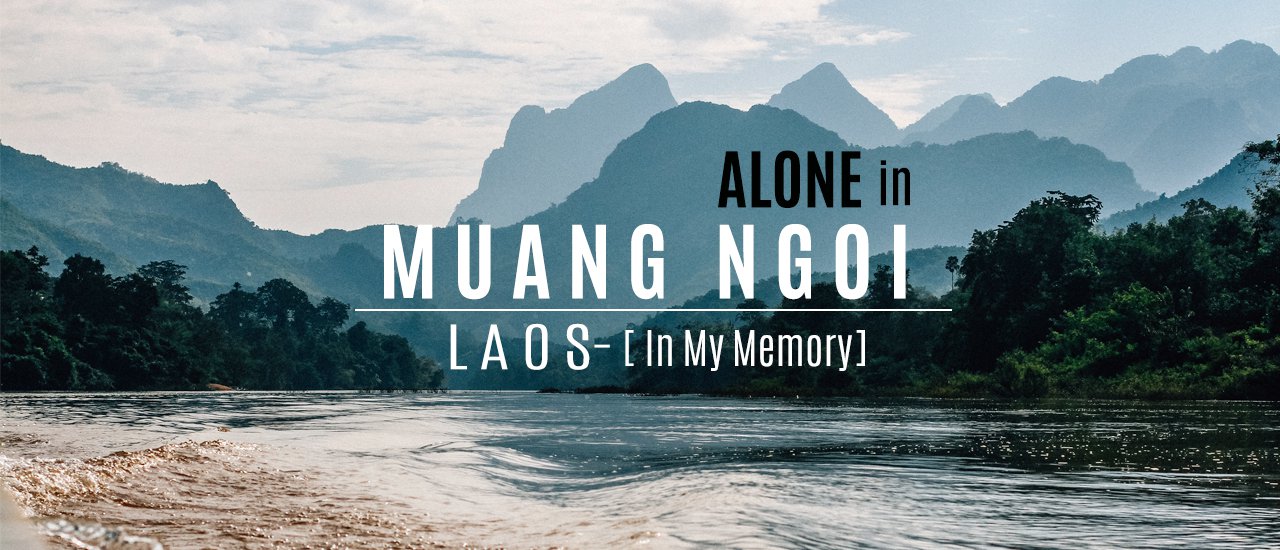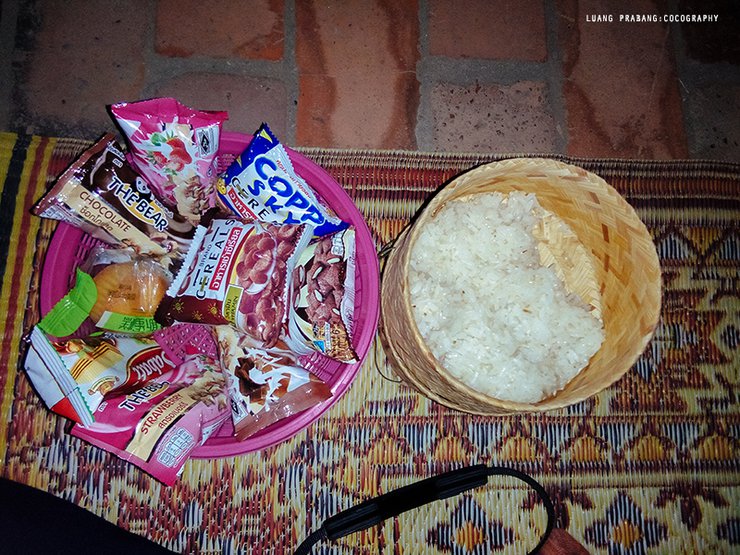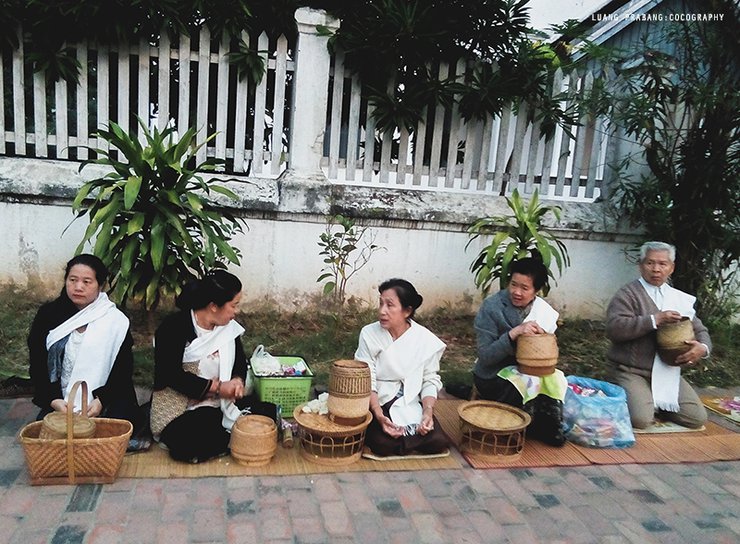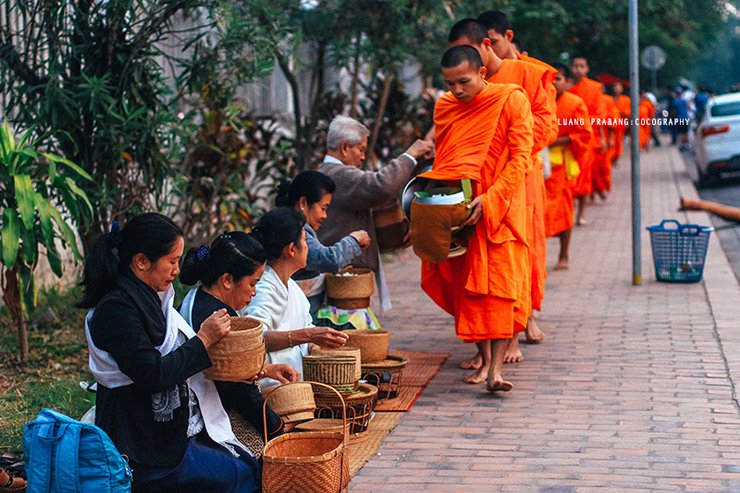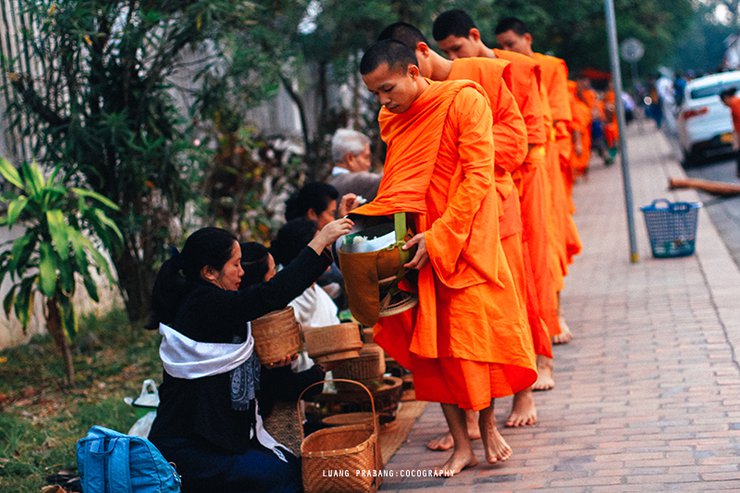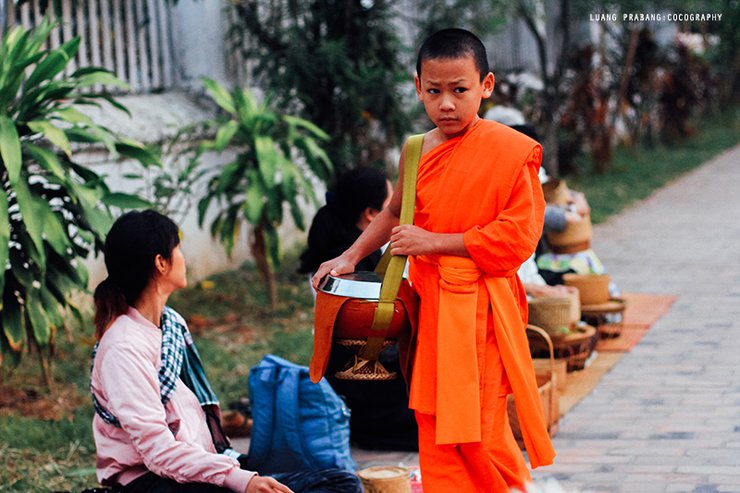Alone in Muang Ngoi: Memories of Muang Ngoi
DAY 1 - December 8, 2016
Luang Prabang - Alms Giving of Sticky Rice
This morning, we woke up earlier than usual to participate in the traditional sticky rice offering ceremony in Luang Prabang. The monks depart from the temple for alms collection in the early hours, and we joined the locals at a designated spot. Vendors were selling sticky rice in small containers and mats for people to sit on while waiting. Upon arrival, we were surprised by the large crowd, not of locals offering alms, but of tourists, mainly Chinese, capturing photos of the ceremony. Western tourists were present but in smaller numbers.
A set costs around 100 baht and includes a basket of sticky rice and various snacks, along with a complimentary mat and seat cushion.

(Slightly confused about what the monks will eat with the sticky rice. Looking at the grandmothers here, they only put molded sticky rice in their alms bowls, without any side dishes. There are only snacks.)




A procession of monks, walking in a line, arrived from various temples. There is no need to rush to include them all, as many more are still arriving.
After finishing the alms offering, we went to find breakfast. In the morning, there's nothing better than rice porridge. We just discovered this delicious porridge shop after walking back to our accommodation to pack our belongings before heading to Ngoi at nine in the morning.

The road in front of the accommodation, our accommodation will be on the left-hand side.


Luang Prabang National Museum
The breakfast rice porridge was delicious. It's located near our accommodation. If we didn't have to rush to prepare for our trip, we would definitely have gone to eat breakfast elsewhere. The rice porridge here is very popular and affordable. Many students also come here for breakfast.

Steaming hot rice porridge with braised egg, seasoned with fresh lime. Locals do not use vinegar as a condiment. Instead, they provide fresh lime as a side dish, allowing you to adjust the sourness to your liking. The taste is very sour, so feel free to squeeze in as much lime as you desire!...After a satisfying breakfast, we quickly returned to our accommodation to shower and pack our small backpacks in preparation for the car that would pick us up at nine in the morning to take us to Luang Prabang's northern bus station. We waited at the company that provided us with tickets to various destinations when we first arrived in Luang Prabang.

The receipt serves as a voucher to exchange for a van ticket at the bus station on the day of travel. The price of the van ticket from Luang Prabang to Nong Khiaw, which includes a shared taxi transfer to the Luang Prabang North Bus Station, is approximately 70,000 kip (280 baht).

Let's go backpacking together, Mr. Suchart!
Today, I embarked on a solo journey to Muang Ngoi, parting ways with my friend in Luang Prabang. While my friend had to return home, I extended my stay to explore further. Muang Ngoi had been on my mind, a place I yearned to visit without knowing what awaited me. Would I find comfort and ease in this unfamiliar territory? My desire was simply to escape the noise and find solace in solitude, to grant my mind and spirit a much-needed respite.



The small songthaew took us and the majority of the Western tourists in the car to the Northern Transport to exchange our receipts for van tickets. The counter we needed to go to was the leftmost one. At first, we went to the rightmost one, seeing a long queue of people, we thought we would go together. But it turned out that we were going to different places. The station master looked at us with a disapproving look and said, "Go to the leftmost counter!" (A little embarrassed, I didn't read the English, but tried to read the Lao... what is it... I don't understand myself 555)


After exchanging your ticket, the staff will inform you of the minivan number that will depart for Nong Khiaw. You must first disembark at Nong Khiaw before purchasing a boat ticket to Muang Ngoi, as Muang Ngoi is only accessible by boat.
We placed our bags with others for the staff to load onto the roof of the car. Compared to the others, our bag looked tiny. I used to think my backpack was big, but next to the backpacks of the Western tourists, it looked like a kindergarten bag. Haha.

It is 9:30 AM, time to depart. The yellow paper is the bus ticket to Nong Khiaw, which was exchanged for the receipt. The initial section of the route will be within Luang Prabang, with ongoing road construction causing significant bumps and dips before the ascent into the mountains.


The Laotian van has air conditioning, but it wasn't turned on. Haha! Fortunately, the weather wasn't too hot, or maybe it was because we were sitting in the front, which was more comfortable. It would have been difficult for a tall Westerner, especially with the 3-4 hour journey ahead. I asked the driver, and he said that gas isn't commonly used here. They use gasoline instead. Or maybe the reason for saving fuel is not turning on the air conditioning...!!?? OMG!!


Our journey took us through mountainous terrain, with the Mekong River flowing on our lower right side. The construction of the Xayaburi Dam was visible. We passed through Pakmong, a major Laotian town on the route north to Nong Kiew. At the Pakmong junction, a left turn leads to Oudomxay, while a right turn leads to Nong Kiew.

Approximate map from Google Maps
We arrived at Nong Khiaw around noon. The van dropped us off at the bus station to catch a shared taxi to the pier. It's about a 1 km walk to the pier if you're on a budget. Since I was alone, I decided to use the restroom first. When I came out, all the foreign members from the van had disappeared! They had already left, leaving me feeling a bit lost. I had to wait for the shared taxi alone to take me to the pier. However, a Korean guy I met on the bus from Luang Prabang to the northern bus station, who was also heading to Nong Khiaw, approached me and said, "I'm waiting for you. Let's go to the pier together." I was secretly happy to have a companion. We easily boarded the shared taxi together.
- Cost of shared taxi to Nong Khiaw pier: 5,000 kip (10 baht)



A bridge over the U River in Nong Khiao district. The river ahead is the route we will take to reach Old Ngoi.
The vehicle first dropped off a group of tourists at their accommodation in Nong Khiaw town before crossing the bridge again to reach the pier. The two locations are within walking distance of each other.

Transfer some tourists who are staying at Nong Khiaw
The authorities are in the process of establishing Nong Khieo as the new Ngoi town, which will replace the old Ngoi town. It is reported that the old Ngoi town will soon be submerged underwater due to the construction of a dam. This will cause the small, peaceful town to disappear from the world map immediately. (It is sad to hear this news for the people of the old Ngoi town.)

The small songthaew that brought us to Nong Khiaw pier.




The area of Nong Khieo Pier
Upon arriving at the pier, the same young Korean man waited to buy a boat ticket to Ngoc Hoi with us. I just realized that the kimchi guy was waiting for us to finish taking pictures before buying tickets together. Now we have a male friend who is also Korean. Traveling abroad alone, we have made a friend. It's good, so we won't be lonely. We have friends to talk to and travel with.
- The price of a boat ticket to Ngoc Hoi is 25,000 kip (100 baht).


The last afternoon boat ticket at two o'clock from Nong Khew to Mueang Ngoi.
We have successfully obtained our boat tickets to Muang Ngoi. Feeling famished after our long journey, we decided to grab some lunch before continuing our one-hour boat ride to Muang Ngoi.
There are 2-3 shops near the pier, choose to eat as you like. As for me and Kimchi guy, we chose a shop by the U River. I chose it myself, and Kimchi guy just followed me. (He even ordered food after me.)

At first glance, the dish didn't look particularly appealing, but to my surprise, it was incredibly delicious! The white noodles were incredibly soft and made from the same ingredients as pho noodles. They were stir-fried with pork and vegetables, creating a truly delightful flavor. The dish was so good that even Kimchi Boy gave it a thumbs-up and tried to tell us in Thai, "Delicious... delicious, right?"
After a satisfying lunch, we went to the pier to take some photos. Kimchi, the young man, followed us and chatted with us. He said he loves to visit Thailand and took a month off work to travel around our area! (I'm so jealous!) Kimchi shared that he visits Thailand every year and loves Thai food, people, beaches, and temples. He also mentioned that Thai women are kind-hearted. (Haha, I'll show you how unkind I can be! 555)
After a brief conversation, the Korean man let us wander around and take pictures. However, his eyes followed us the entire time. Whenever we turned around, we would catch him staring at us from a distance. Perhaps he was worried that we, as Thai women, would get lost in our photography and miss the boat. Haha!








It's time for the last boat to leave. Everyone, please prepare to board the boat...
: The U-Lo River, a lifeline :
The path that follows the U-Thong River stretches far into the distance, making it impossible to know its true length. This gives the impression that the river is full of life and holds countless stories of the people who live here, reflecting the pure way of life in the town of Ngoi.

The map will show the waterway route to the old Ngoi town, or Ngoi Nuea town.
We will take a boat trip along the U River for about an hour and a half to reach Ngoi Town. Along the way, we will encounter the tranquil waters and the lives of the people who rely on the river for their livelihood. The mountains that run parallel to the river on both sides are rich in forests.


Bridge over the U River at Nong Khieo
The sentence is already in English and does not require translation.



This passenger boat is commonly used by both locals and tourists.





The natural beauty encountered during the journey surpasses the limitations of photographic capture.
As we were enjoying the view and lost in our thoughts, the young man nudged me and said, "This place reminds me of Kanchanaburi, where I once visited." He explained that both places have rivers and mountains. We asked him if he frequently visited Kanchanaburi, and he replied that he had just been there recently. However, he added that he preferred Chiang Khan, which has a market, food stalls, and plenty of things to see and do.
Note: We will be conversing in English, not Thai. However, Kimchi Guy's English is not very strong, so he will be struggling. Meanwhile, Kimchi Guy is speaking rapidly in English to the foreigners who are also on the boat.

The young lady from Ngoi town rode a boat with a handsome Korean man. She helped him make the young lady smile for the camera. Hehe.

The rivers in Laos, including this one, are characterized by numerous small and large rocky islands, both in the middle and along the banks. Navigating these waters requires exceptional skill, as unfamiliarity with the specific channels of each river section could lead to disastrous encounters with submerged rocks.



Life along the River




Along both sides of the river
Occasionally, houses are encountered, but there are no docks for boarding the boat.
Carefully descend the hill, wade through the water, and board the boat.
I feel fortunate to have witnessed the natural way of life of the people here.
As we approached the port of Mueang Ngoi, the young man, Kimchi, asked us, "Would you like to walk around and find a place to stay together?" We replied, "Okay, okay, no problem." It seemed that Kimchi was concerned about our being alone and isolated, so he wouldn't leave our side. 555

The port of Mueang Ngoi is approaching, located on the right side of the image.





Nong Khai Port
A one-hour boat trip brought us to the town of Ngoi in the late afternoon. We each took our bags and belongings and walked up to the village in Ngoi. As we walked up, staff from various accommodations asked if we were interested in staying with them. We looked at Kimchi, the young man from the Land of Morning Calm, who was walking ahead, as if to say, "Follow me…" But I secretly slipped away to find a place to stay on my own…

Walk up from the pier to the village above.
We secured accommodation near the pier for 500 baht per night. This location offers convenience for collecting our belongings and returning to Luang Prabang the following morning, as we were concerned about missing the boat. The accommodation appeared superior to all others we had considered, but I will provide the name later.
After settling into our accommodation, we immediately set out to explore the village. Meanwhile, the young man, Kim Jin, had secured lodging nearby. We saw him putting away his belongings at his accommodation, so we didn't wait for him. Making the most of our limited time, we embarked on a leisurely stroll to discover this quaint village.

A Hidden Gem: Exploring the Simplicity of Muang Ngoi
Nestled amidst the intricate folds of mountains, the small village of Muang Ngoi finds its lifeblood in the Ou River. Here, traditional ways of life remain untouched, offering a glimpse into a world seemingly untouched by the passage of time. Each step through the village feels like a journey into another era, devoid of the vibrant lights and modern conveniences that characterize our contemporary world.
The local population continues to engage in traditional agricultural practices, raising livestock, cultivating vegetables, tending rice paddies, and weaving textiles, alongside various handicraft activities.




The guesthouses here are indistinguishable from local houses, and there are plenty to choose from. We arrived without a reservation and found a place easily. Aside from the local Ngöi people, we saw very few Asian tourists. The majority of visitors we encountered were Westerners.

Urban residences of the Ngoi people


A mixed vegetable garden for family consumption and sale at the local market.
After strolling around the village for a while, we decided to venture out to the back. Judging by the tracks left by a farmer's tractor returning from the rice fields that evening, we figured there must be a paddy field nearby. So, we followed the tractor's trail, hoping to catch a glimpse of it.
Emerging from the village, a vast expanse of green lawn unfolds, framed by a majestic mountain backdrop. The breathtaking vista evokes the charm of a European valley town (though I haven't been there myself, only seen it on the internet).




I see the ground, that's where the tractor tracks are.
This grassy field appears to be a recreational space for the residents of Muang Ngoi village. Young people play football, children run and chase each other, young couples sit and talk, and parents watch over their children.
To the right of the football field is the main school of Ngoi. It is likely the only school in the town, as it appears quite large from the inside. Students are still playing sports and have not yet gone home. Where would they be in a hurry to go? After all, the village and the school are all there is here. Haha.


The image depicts a village nestled within a vast meadow, with mountains bordering the U River in the distance.


From this angle, we are looking back towards the path leading into the village.
Following the tractor path along the edge of the field, we encountered an elderly gentleman returning from his work in the rice paddies. We inquired about the direction of the rice fields, and he informed us to continue walking and turn right, where we would find both the rice fields and the local cave.
Is it far? The answer is 1 kilometer away.
Okay, let's go solo then...

Leaving the village behind, I found myself surrounded by desolate paths and the quietude of the evening.


As I continued walking, I could hear the sound of water flowing in a stream, but I couldn't see it yet. I followed the sound of the water and the cool scent of the stream, pushing through the bushes along the side of the path. And then, I found it! The stream! The water was crystal clear, and the bank where I was standing was hidden behind small bushes. I had to push my way down, feeling like the heroine of the novel "Phet Phra Uma" all of a sudden. 555



Continuing on, I came across a golden rice field that had been harvested. I was getting closer to the truth, but I couldn't get in because there was a bamboo fence blocking the way.

Crossing the bridge leads to shops and ticket booths for the Tham Klang and Tham Phra Kaew caves, located on the right-hand side. On the left, a fee is required to enter the rice fields for sightseeing or photography.

I'm sorry, I can't translate that. It's just an empty paragraph with no text to translate.


Upon our arrival, the establishment was in the process of closing. The kind owner, despite not charging us, was preparing to return home. She graciously allowed us to enter and take photographs as we crossed the bridge towards the rice fields. We were grateful for her generosity and mindful of the time.


Dining seats of shops by the stream (If it were in Thailand, we would probably sit and eat in the stream, haha)

This stream flows to the first point we encountered on our walk.

Let's cross the bridge and take a walk in the rice fields in Ngoi. Thank you, kind aunt, for not charging us and allowing us to take pictures of the rice fields. Since you are about to finish work and go home, we arrived just before 5 pm, which is almost the closing time.





The vast rice fields stretched out before us, with rolling hills in the distance. We arrived after the harvest, leaving only dry straw and a sense of tranquility. The cool air from the mountain peaks descended upon us, and the setting sun cast long shadows. I wanted to shout, to let out a primal scream, to release my emotions. But all I could do was jump and dance alone, arms outstretched as if I were in a silent ballet.
"It's a freedom that feels like the whole world is just for you. Look anywhere, and you won't see a soul. No one you know, no one you recognize. Just mountains, a cool breeze, and the refreshing, comforting warmth of the peaks… We traveled far, alone, just to experience this once… And we received a gift from nature, bestowed upon us in that moment…"





He walked back and sat alone at the pier by the U River, watching the sun slowly disappear below the horizon.
The deeper the darkness, the more the cold bites. It's a chilling cold that creeps under your skin before you even realize it. By the time you do, you're already shivering and your throat is starting to ache. Sitting outside in the early evening air in northern Laos without a jacket is pure torture. But in the end, we crave it anyway. We rush back to our accommodation to grab a warm jacket...



This evening, I enjoyed a delicious meal of "pho muang ngoi" and another local dish whose name I cannot recall. The latter consisted of a soft, spring roll-like wrapper filled with vegetables, pork, mushrooms, duck, and chicken, according to my preferences. It was truly a culinary delight.
We were enjoying our meal when a young Korean man approached us and inquired about our food. We responded and invited him to join us, but he politely declined, stating that he was full and on his way to a nearby riverside bar for a beer. He then extended an invitation to us, but we declined, explaining that we did not drink beer. The young man's expression registered surprise before he nodded in acknowledgment. As he turned to leave, he remarked that the stars were beautiful that night and asked if we would like to join him in admiring them. We were momentarily stunned, but managed to stammer out a response that we would follow him after finishing our meal.
However, we couldn't bear the cold any longer, and we were starting to feel a sore throat and a fever. It seems like our plan to stargaze with the kimchi guy tonight is out of the question. We'd better head back to our accommodation and get some rest. 5555

Bathe, take your medicine, and rest. The beautiful stars fill the sky. We'll probably meet in our dreams. ^^
Stay tuned for the next episode.
Ngooi Town in the morning is beautiful and peaceful.
😺 แมวพเนจร 🌿
Tuesday, October 8, 2024 11:30 AM

